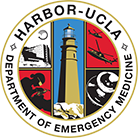We need you! Join our contributor community and become a WikEM editor through our open and transparent promotion process.
Altered mental status (peds)
From WikEM
(Redirected from Altered Mental Status (AMS) (Peds))
Contents
Background
- Both cerebral cortices must be affected to cause altered mental status
Pediatric GCS[1][2]
| Eye Opening | Verbal | Motor |
| 6: Normal spontaneous movement | ||
| 5: Smiles, coos, babbles | 5: Withdraws to touch | |
| 4: Opens eyes spontaneously | 4: Irritable, crying (but consolable) | 4: Withdraws to pain |
| 3: Opens eyes to speech only | 3:Inconsolable crying or crying only in response to pain | 3: Abnormal flexion to pain (Decorticate response) |
| 2: Opens eyes to pain only | 2: Moans in response to pain | 2: Abnormal extension to pain (Decerebrate response) |
| 1: Does not open eyes | 1: No response | 1: No response |
Note:
- For Motor score 4, pain is defined flat, fingernail pressure (often performed with the barrel of a pencil).
- For Motor scores 2 and 3, pain is defined by pressing hard on the supraorbital notch. If this unsuccessful, sternal pressure may also be attempted.
Clinical Features
Differential Diagnosis
| A | Alcohol | O | Opiates |
| Acid-base and metabolic disorders | U | Uremia | |
| Diabetes mellitus | Chronic renal failure | ||
| Dehydration | Hemolytic-uremic syndrome | ||
| Hypercapnia | T | Trauma | |
| Hepatic failure | General trauma with hypovolemia | ||
| Hypoxia | Head injury | ||
| Inborn errors of metabolism | Mass lesion | ||
| Arrhythmia and cardiogenic causes | Cerebral edema | ||
| Ventricular fibrillation | Cerebrovascular accident | ||
| Adams-Stokes attack | Electric shock | ||
| Aortic stenosis | Decompression sickness | ||
| Pericardial tamponade | Tumor | ||
| E | Encephalopathy | Thermal extremes | |
| Hypertensive encephalopathy | I | Infection | |
| Reye syndrome | Meningitis | ||
| Hemorrhagic shock and encephalopathy syndrome | Encephalitis | ||
| Brain abscess | |||
| Postimmunization encephalopathy | Visceral larva migrans | ||
| Disseminated encephalomyelitis | Severe systemic infection | ||
| Human immunodeficiency virus disease | Intracerebral vascular disorders | ||
| Subarachnoid hemorrhage | |||
| Endocrinopathy | Venous thrombosis | ||
| Addison's disease | Arterial thrombosis | ||
| Congenital adrenal hyperplasia | Intracerebral or intraventricular hemorrhage | ||
| Thyrotoxicity | |||
| Cushing syndrome | Cerebral embolus | ||
| Pheochromocytoma | Acute infantile hemiplegia | ||
| Hepatic porphyrias | Acute confusional migraine | ||
| Electrolyte abnormalities | Moyamoya malformation | ||
| [Na+], [Ca2+], [Mg2+], PO4 |
P | Poisoning | |
| I | Insulin | Psychogenic unresponsiveness | |
| Hypoglycemia | S | Seizure | |
| Ketotic hypoglycemia | Shunt malfunction |
Evaluation
- Labs
- Glucose, CBC, chem, UA, CSF, LFT, utox, VBG, BAL, thyroid, Calcium (ionized)
- ECG
- Neuroimaging
- XR
- Urine
Treatment
- Immobilize cervical spine for suspected trauma
- Fluid resuscitation 20 mL/kg x3 as needed; start pressors thereafter
- Antibiotics for sepsis or meningitis (consider viral it patient is toxic)
- Naloxone for opiate or clonidine overdose (0.01-0.1mg/kg IV q2 min)
- Glucose for hypoglycemia (2 mL/kg of 25% dextrose)
- Avoid sodium bicarbonate for metabolic acidosis unless pH <7.0
- Control seizures
- Prevent hypothermia, treat hyperthermia
See Also
External Links
References
- ↑ Holmes JF, Palchak MJ, MacFarlane T, et al. Performance of the pediatric glasgow coma scale in children with blunt head trauma. Acad Emerg Med. 2005 Sep;12(9):814-9.
- ↑ James HE. Neurologic evaluation and support in the child with an acute brain insult. Pediatr Ann. 1986 Jan;15(1):16-22.
